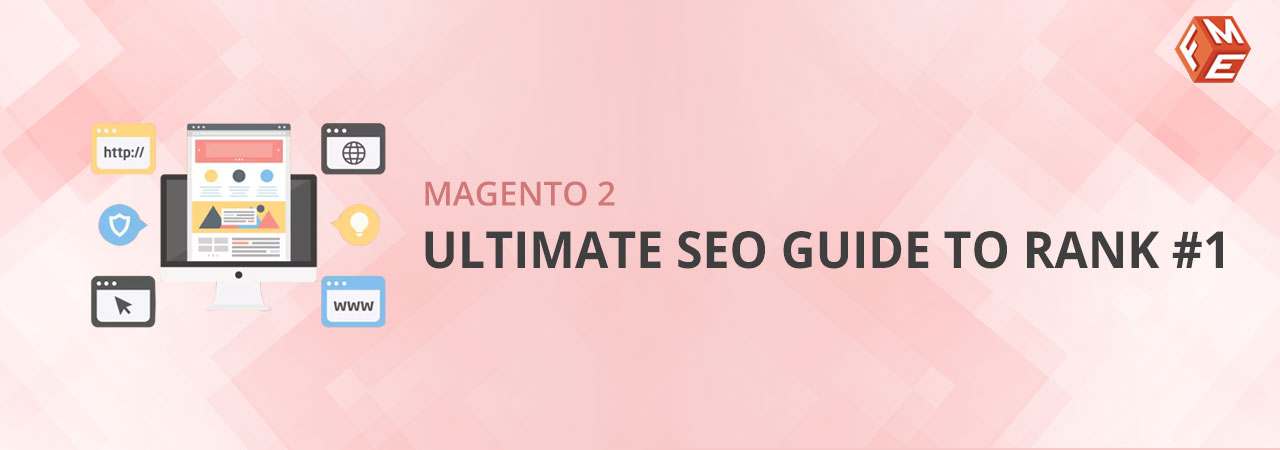Today you’re going to learn EXACTLY how to configure Magento 2 SEO settings and rank your store.
In this complete Magento 2 SEO guide you’ll learn:
- Product keyword research & buyer's intent
- How to set SEO-friendly URL
- How to write SEO-friendly title tags, meta descriptions and alt text
- How to optimize product page content
- Technical SEO optimization in Magento
- Advanced Off-page SEO tactics
- Lots more
Let’s dive in.
Magento is, without a doubt, one of the leading ecommerce platforms today. According to statistics (not official though), Magento hosts more than 250,000 stores worldwide out of which around 11,000 stores run on Magento 2. This accounts for 12% of all ecommerce sites. According to CloudWays, Magento is the second most popular ecommerce platform after WooCommerce.
The platform witnessed massive growth in the years 2017 and 2018. This was partly due to its acquisition by Adobe in May 2018 and partly due to the introduction of Magento 2. Both these initiatives proved to be a breeze of fresh air for Magento and increased its popularity manifold. It’s hard to resist the out of the box, exciting features of Magento 2 required to make a store more scalable, secure, fast, easy to manage, and high-performing.
All this is true but how to make the most out of a Magento store in terms of sales? This is the question you would definitely have in mind. So here is the answer.
A lasting and cost effective way to generate sales is to generate targeted organic traffic to your website. This is only possible if your website ranks well in relevant SERPs. So what you have to do to rank your Magento store on top of Google SERPs? This is what we are aiming to achieve in this default Magento 2 SEO guide. We will be covering everything from basic to advanced and from very important to not-so-important SEO factors and settings (within and outside Magento) that contribute to a Magento store SEO optimization.
1. Keyword Research
Keyword research is the first step to start with in your SEO journey. It’s the foundation that will help you determine what keywords to go after. This discovery will influence all the subsequent SEO efforts whether it’s technical SEO, ON-page SEO or OFF-page SEO.It’s very important that you find the right keywords for Your product and category pages. If not, all your efforts will go in the wrong direction which will yield no results.
1.1 How to Research & Choose Keywords for your Magento Product & Category Pages?
You need to hunt keywords that give you sales. Since you will be selling products on your Magento store, your keywords should be product-specific with users intending to buy. Following are the three dimensions to consider while doing keyword research.- Competition
- Monthly search volume
- Buyer’s intent
Finding the perfect balance of competition, search volume and buyer’s intent is challenging. Ideally, you should be aiming for keywords that have high search volume with good buyer’s intent. This often comes with high competition. Keywords that have high search volume are highly competitive as everybody else is trying to rank for them. Low search volume keywords are often less competitive.
The challenge
If you go after highly competitive keywords (with high search volume), it can not only take an indefinitely long time and efforts for you to beat the giants lying on top but also the audience for such keywords may be unfocused. On the other hand, choosing low competitive keywords (with low or no search volume) means less people or no one will search for your products. So how to find the perfect balanced keywords? We will look at it later. First, lets understand buyer’s intent.
Understanding Buyer’s Intent
User intent describes what a user is looking for when they conduct a search query. They may be looking to find some information, get to another site or buy a product. Your selection of keywords for your site will determine with what intent users will access your site.
If you are driving traffic to your store with low buyer’s intent, you will have a high bounce rate and low conversion rate. People may come to your store but will not stick around as you don’t offer what they are looking for. Also, your page might rank well but the product you are trying to sell could have little to no conversions at all.
For example, if your page sells an SEO extension for Magento 2, the keyword “Magento 2 SEO extension” has a high buyer’s intent than the keyword “Magento 2 SEO”. The former indicates that the user is looking to buy an SEO extension while the latter is a more broad keyword which the user can search to find information about SEO for their Magento 2 store. Similarly, “online marketing tools” will have a far more targeted audience than just “online marketing.”
The Solution
Place your content in context with the volume of the keywords. Judge how likely a particular keyword is going to result in engaged users, along with the value of your content.
Initially, go for long tail or niche keywords as they have high buyer’s intent. They are easier to rank for and high converting. At the end of the day, it’s better to have low but targeted traffic than to have high traffic with no conversions. And it’s better to rank for low competitive keywords that generate you some revenue in the first 3 months than not being able to rank for high competitive keywords in the entire year.
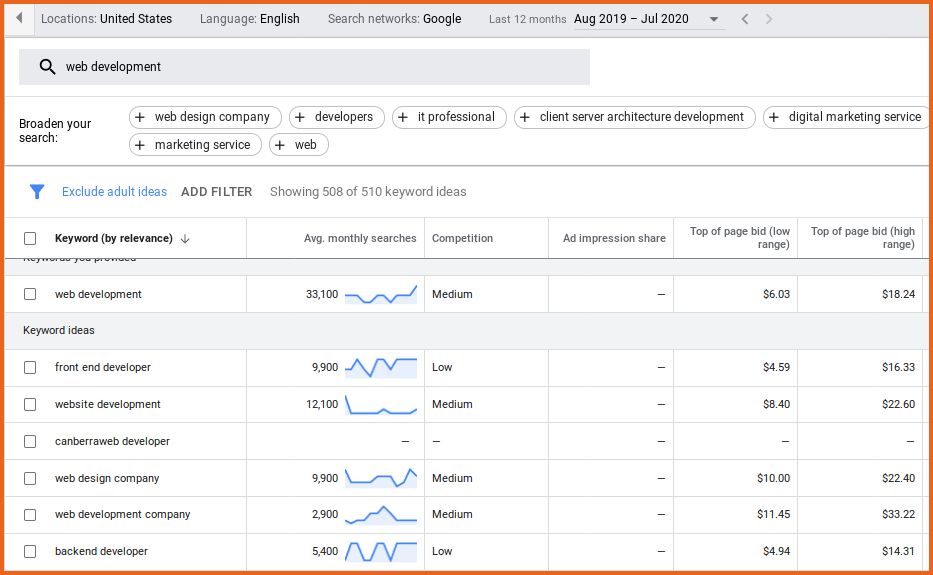
- Google Keyword Planner (Free)
- Ahrefs Keyword Explorer (Paid)
- KeywordTool.io (Free)
- Moz Keyword Explorer (Paid)
- SEMRush (Paid)
2. Magento ON-Page SEO Settings
By now, you will have collected a list of keywords that you would like to rank for. Now it’s time to optimize your product and category pages for these keywords. These two pages will generate most of your traffic and sales. When we are talking about on-page SEO, the following factors hold special importance.- URL structure
- Meta Title
- Meta Description
- Page Content
- Image Alt text
- Internal Links
2.1 URL Structure
Your URLs should be:- Short
- Keyword rich
- No special characters
- Lower case
- Consistent
2.2 Optimizing Meta Title
Meta title acts as a name tag for the web page. It briefs search engines what the page is all about. Search engines display Meta tilte as clickable headline in its search result pages.

Meta title is the most important place to place your keyword. Since you can prolong meta title up to 60 characters, its best to add modifiers such as “best”, “top” “cheap”, “high-quality” or your brand name to it. It will help you rank for more long tail searches.
It’s also wise to add words that encourage users to click on your search result. Words like “% OFF”, “Ultimate”, “Free Shipping” can significantly increase your CTR (Click Through Rate).
So instead of just making your keyword “Magento 2 SEO Extension” as your Meta title, you can optimize it a little further like “The Best Cheap Magento 2 SEO Extension | 30% OFF”.
2.3 Optimizing Meta Description
Although Meta description is not a direct SEO factor, an optimized description will help increase your page’s CTR. Meta description is displayed in SERPs just below Meta title.
You can write a description of up to 160 characters so you have more room to add enticing words and phrases in addition to your keywords. Try to include phrases like the following to get more clicks. You can also include distinguishing features of your product to grab customer’s interest.
“We are running a X% Off on all our products for a limited time.”
“Get FREE shipping on all our products today.”
“Get heavy discounts on _ today.”
2.4 Optimizing Page Content
Writing content that satisfies both users and search engines is the hardest part. You not only have to sell your product to customers but also convince search engines that your product page is worthy of ranking above your competitors. Here is how you can do this:
1. Cover Your Product From Every Angle
The more content you provide about your product, the better. Long content tends to rank best. It signals search engines that you have the most in-depth product knowledge while customers also get everything that they need to know. Cover every area of the product. Take your product’s descriptions to 1000+ words.
2. Include Keyword Multiple Times
Make sure to include your targeted keywords at least 3 times. Don’t make it look like you have forcefully included them though. Just use them contextually. It will help Google understand what your page is all about.
3. Use LSI Keywords
LSI (Latent Semantic Indexing) keywords are keywords that are closely related to or synonyms of your primary keywords. Google displays LSI keywords at the bottom of SERPs. They help search engines deeply understand the page’s overall topic and bring authority to the content.
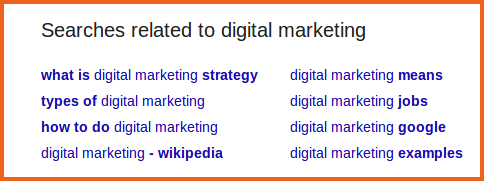
URL, Meta Titles and Descriptions Settings in Magento 2
Choose a particular CMS page by going to Content → Pages → Edit from Magento 2 backend. Now expand the Search Engine Optimization section. Here you can update the Meta title and description for the page. Click Save when you are done and it will be displayed on the front end.
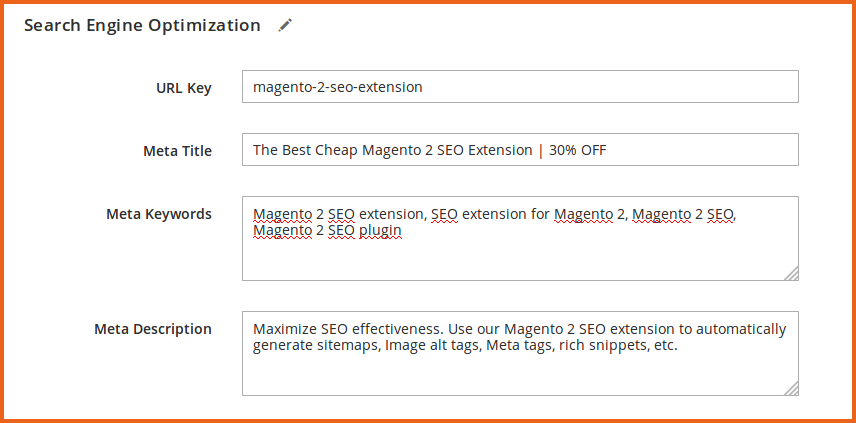
3. Magento Technical SEO
Don’t forget to fix the technical aspects of your website when trying to rank it. Technical SEO is as important as on-page or off-page SEO. It makes sure that technically there is nothing that hinders your website from ranking well. Technical SEO helps search engines crawl and index your site more effectively. One minor mistake here and you will be punished heavily.
Following is the technical SEO checklist.
- Robots.txt
- Sitemaps
- Redirects
- Content duplication issues
- HTTPs
- Site speed
- Rich snippets
Technical SEO Optimization in Magento 2
Magento allows you to configure technical SEO settings from within its Admin panel.
3.1 Robots.txt
Robots.txt is a file that tells search engine crawlers which pages on your site to crawl and which not to crawl.
- From Magento 2 Admin, go to Content → Design → Configuration.
- Click Edit for the website in the Action column.
- Expand the Search Engine Robots section.
- Choose one of the 4 options in the Default Robots dropdown Or
- Make changes to the Edit custom instruction of robots.txt field.
- Click Save Configuration.
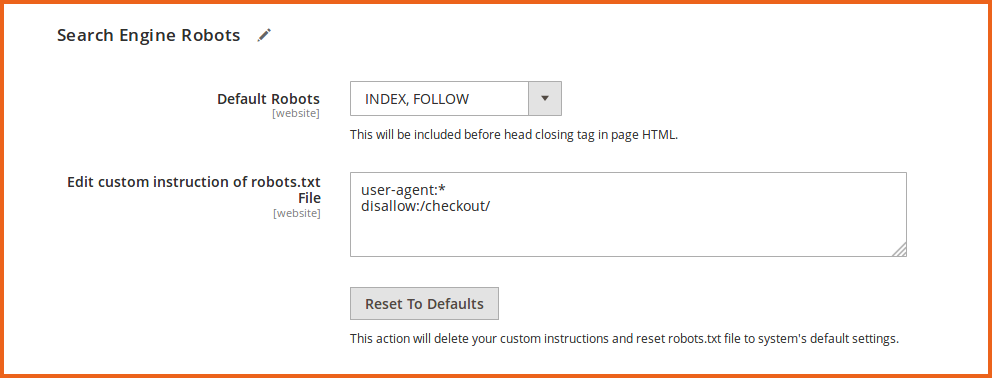
directories:/catalogsearch/,/catalog/product_compare/,/wishlist/
You can automate this with our noindex nofollow tag module.
3.2 XML Sitemap
The XML sitemap file contains links of all the pages on your site available for crawling. It gives search engines a road map of the content on your website which makes their job easy.
First, you have to enable submission to robots.txt which will submit the URL of your XML sitemap to your robots.txt.
- Go to Stores → Settings → Configuration → Catalog → XML Sitemap.
- Expand the Search Engine Submission Settings section.
- Change Enable Submission to Robots.txt to Yes.

- Click on Marketing → SEO & Search → Site Map.
- Click Add Sitemap.In the New Site Map view, enter the following values:
- Filename:sitemap.xml
- Path:/media/
- Click Save & Generate. The new site map becomes available in the Site Map grid.

Use our XML & HTML sitemap extension to automatically generate sitemaps for your Magento 2 store.
3.3 Redirects & URL Rewrite Settings in Magento 2
You can optimize the default settings for redirects and URL rewrites. You can also add new redirects. Lets look at the default settings first.
- Go to Stores → Settings → Configuration → General → Web.
- Under Url options:
- Keep Add Store Code to Urls to its default No to make sure URLs are descriptive and easy to read.
- Change Auto-redirect to Base URL to Yes (301 Moved Permanently) to make sure link authority is passed on.
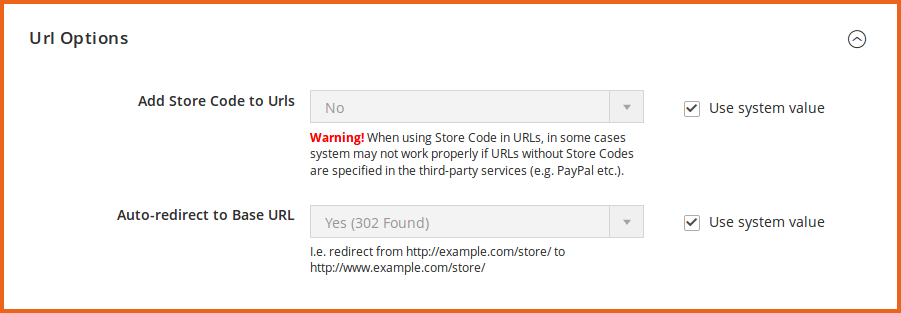
- Go to Marketing → SEO & Search → URL Rewrites.
- Click Add URL Rewrite.
Fill in the following 2 mandatory and important information.
Request Path: Enter the path you want to redirect.
Target Path: Enter the path you want to be redirected to.
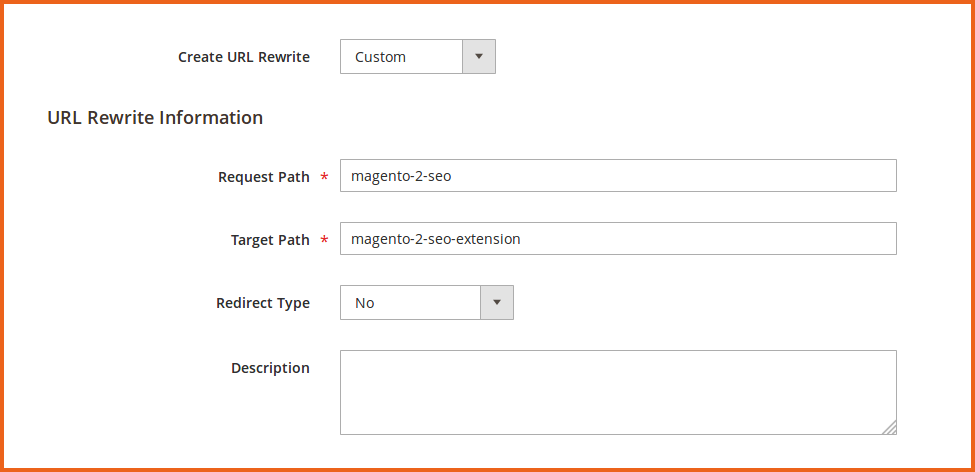
3.4 Content Duplication Issues
Duplicate content is one of the most common SEO issues in ecommerce stores. This happens mainly due to a lot of unique URLs for product & category pages with almost the same content. For example, multiple product or category pages may have the same or very similar content i.e. product descriptions, features, guidelines etc. This can also happen if you have a snippet of text that appears on multiple pages.
To solve this issue, canonical tag is used. A canonical tag on a page tells search engines that this page is an exact copy of the destination URL ( ) and hence should not be treated as a unique page.
To turn on the use of canonical URLs in Magento 2:
- Go to Stores → Settings → Configuration → Catalog → Search Engine Optimization.
- Turn both Use Canonical Link Meta Tag for Categories and Use Canonical Link Meta Tag for Products to Yes. This will result in both product and product-category pages having canonical URLs.

We have developed Canonical tag extension with lots of features that will help you avoid content duplication issues even if you are a naïve.
3.5 HTTPs
Nothing is more important for a customer shopping online than security. It’s of utmost importance that you serve them over a secure connection.
To enable HTTPs in Magento 2:
- Go to Stores → Settings → Configuration → General → Web.
- Expand the Base URLs (Secure) section.
- Change the Use Secure URLs on Storefront and Use Secure URLs in Admin to Yes.

3.6 Site Speed
Speed is the only thing that affects your rankings, conversions and user experience all at the same time. The fact that 40% of customers abandon a site if it takes more than 3 seconds to load is enough to understand the importance of speed.
Fortunately, Magento 2 has an efficient caching system that reduces a store’s loading time and greatly improves its performance. For a fast-loading Magento site, make sure you have the best hosting platform so that there is no delay from server side. Investing in a good web hosting will eventually pay off. Your hosting platform should be:
- Optimized for Magento
- Ready to support Redis and Varnish
- Running on Nginx
- CDN compatible
More Details: Recommended Magento 2 Web Hosting ServicesLarge images are one of the most common reasons of slow-loading websites. Make sure to compress all your images without compromising their quality so that their sizes are minimum. It's best to convert images to webp which is Google's recommended image format. To enable caching features in Magento 2:
- Go to System → Tools → Cache Management.
- Mark all checkboxes, select Refresh from the drop-down box, and click Submit.
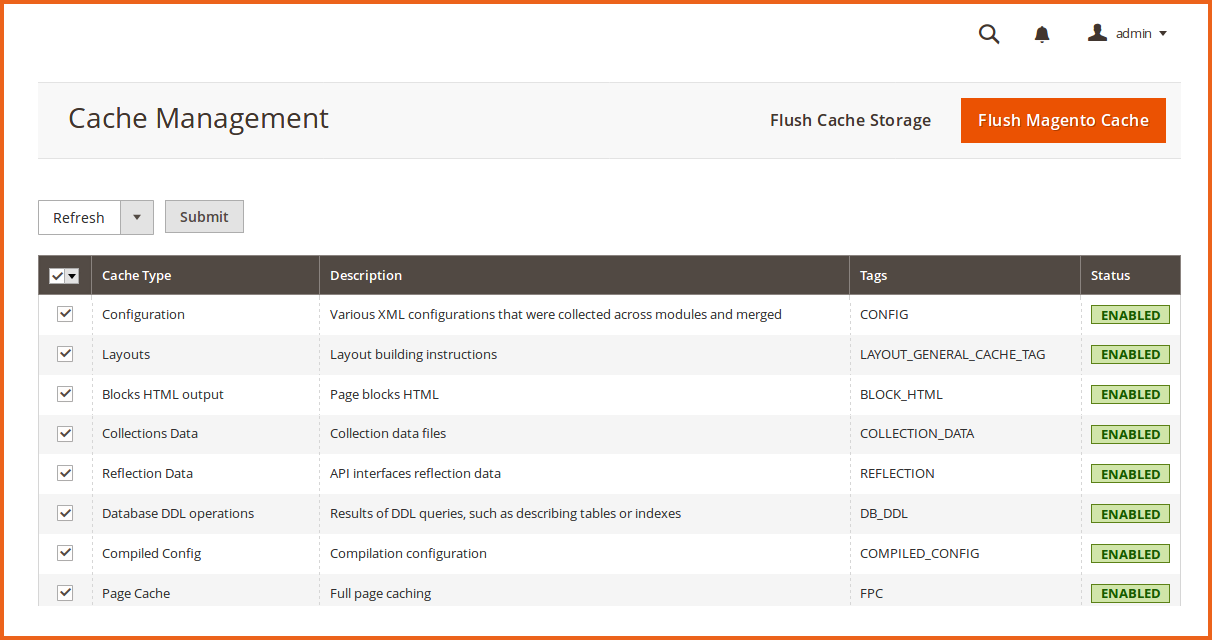
3.7 Rich Snippets
Google normally displays the URL, Meta title and Meta description in it’s search results.
Rich snippets instruct search engines to display additional data which makes search results look more eye catching and thus increase CTR. Common rich snippet types are reviews, rating, and events. Here’s an example:

Ecommerce sites can significantly leverage rich snippets by displaying ratings, reviews and prices of products. You can get rich snippets by implementing Schema markup in your product pages.
Schema is code that help search engines return more valuable information for users. Although Google has said Schema markup is not a direct ranking factor, it does improve organic CTR. Products with Schema markup tend to rank more easily than products without it. It’s one of the most powerful but less utilized SEO techniques.Take advantage of our Magento 2 Rich Snippets extension.
4. Magento 2 Off-Page SEO
By now, you have established a solid relevancy and technical base for your Magento store. You have effectively conveyed to search engines what your site is all about through on-page SEO and made indexing and crawling easier for them through technical SEO. Now it’s time to increase your site’s exposure and authority in the digital world which is done through off-page SEO.
Off-page SEO is synonymous to link building. Google uses links from other websites to your website to determine your website’s popularity and consequently assign you a ranking. For high quality backlinks, it’s important that your linking domains are:
- Relevant (For example, a shoes online store obtaining link from a gaming website is considered a poor link)
- Have good domain authority
- Trustworthy
- Have unique, fresh, and useful content
There are broadly 3 ways to obtain backlinks.
Natural Links: These are the links that third party websites give you without any action on your part. Such websites may have found your content highly relevant and useful for their own audience. To earn such links, your content must be of high quality so that other websites in the industry can’t resist linking to you.
For example, lots of SEO related websites will willingly link to Neil Patel, Moz, or Search Engine Land for the benefit of their own audience.
Manually Built Links: Such links are acquired through link building activities such as guest blogging, outreach, and influencer marketing. When done correctly, these back links can significantly contribute to your site’s high ranking and traffic.
Self Created Links: These link building practices can sometimes do more harm to your website than good. They come under black hat SEO and include adding a backlink in an online directory, forum, blog comment signature, or a press release with optimized anchor text.
To start off getting backlinks for your Magento 2 store, participate actively in all the Magento 2 forums. These forums have your targeted audience that might be looking for solutions. Help them by answering their queries and in the process direct them to your store.
Devise an effective guest blogging strategy to post your content on relevant high DA websites with a link back to your website. This will help you establish your authority in Magento community. Reach out to Magento experts or influencers to market your store on their blogs/channels.
Summary
SEO is a continuous process so you have to constantly update/add useful content and earn quality backlinks. It may be hard and time consuming, especially if you are in high competition but with the right strategy and consistency, you can occupy the coveted #1 ranking.
Magento comes with all the technical SEO settings that, if configured correctly, can take you to take spot. All you have to do is work diligently on the other two pillars of SEO i.e. relevance and authority. As they say, content is the king and backlinks are the queen in the world of SEO.
Related Articles:

